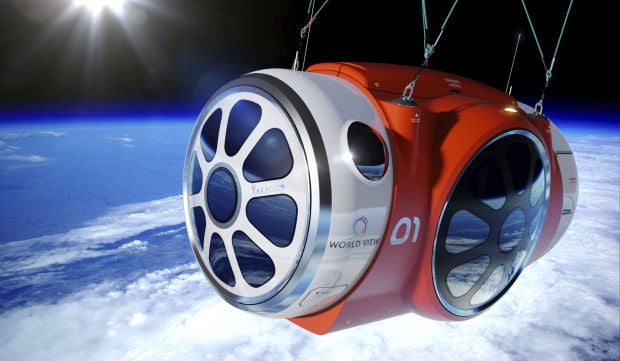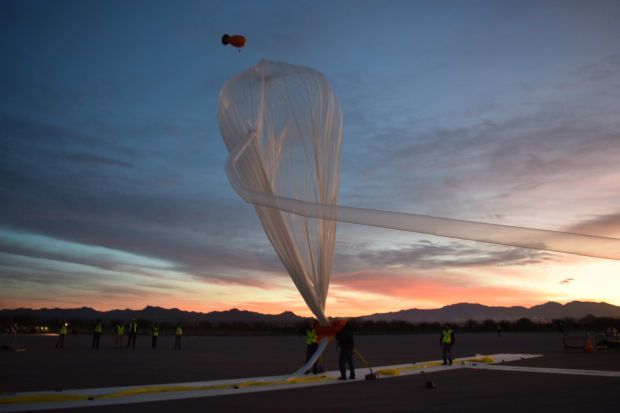We are all about to become near-space entrepreneurs.
You, me and everybody else in Pima County will have a financial interest in $75,000-per-person voyages and research trips to the upper atmosphere, so close to space you can almost reach out of the capsule and touch it.
An item on Tuesday’s Pima County Board of Supervisors agenda would have the county borrow $15 million to build an office/hangar/manufacturing building and spaceport for World View Enterprises, a Tucson company. World View would then lease back the property from the county and have the opportunity to buy it after 10 years.
The Spaceport would remain in our hands in perpetuity — a 700-foot-diameter concrete circle that is the cheapest part of the project, at $500,000.
Formally, as with any county board agenda items, the deal could be voted down. But these big incentive deals don’t get put on an agenda unless they’re going to be approved. I consider it a done deal.
That doesn’t mean it’s a good deal, though. On the surface, it looks plausible — renowned locals Taber MacCallum and Jane Poynter own the business and say it is poised to ... oh, what the heck? ... take off. They’re projecting 448 jobs by 2021, up from 25 now.
A tantalizing prospect? For sure. Risky? Yep.
County Administrator Chuck Huckelberry acknowledged that to me when I talked with him on Friday.
“Everything in this world is a risk,” he said. “Unless you compete you’re going to be mediocre.”
That’s the argument for this public investment, one I’m sympathetic to. But big hopes, like propelling our community into the space industry, also sometimes crash into harsh realities.
So if I were a board member, I’d like to hear satisfactory answers to these and other questions before I voted “yes.”
1. Why can’t the company finance this deal themselves?
This is one of those questions we should ask any time a private company requests public incentives.
The simple answer, often is, it’s cheaper for them this way. And, indeed, interest rates tend to be lower when the county sells certificates of participation rather than having the company find financing on the open market.
In the end, the cost to county taxpayers in both principal and interest is projected at $20.3 million, Huckelberry said. But if the project plays out as projected, the county will have made money by the end of year 18, and the projected gain is $3.4 million by the end of the 20-year deal.
The scarier possibility is that the project is just too risky, the industry too early in its development, to find financing on the open market.
Finally, there’s the possibility that competition from other possible locations forced us to finance and build. Which leads to my next question:
2. How real was our competition?
Huckelberry said competitors in Florida and New Mexico, where there are existing spaceports, offered better deals than Pima County did — $15 million to $20 million better. But we offered enough to win the nod from the locals at World View and keep them home.
Did we really have competition from other states? Over and over again across the country, companies have played alleged competitors against each other when the company already had its mind made up. It’s a dangerous game.
However, in this case, we know there are underused spaceports around the country, including in Florida and New Mexico, where the state government paid about $219 million for a barely used spaceport where rocket-powered vehicles could take off. So it’s pretty likely they actually wanted someone, anyone, to move in and start using them.
When I asked Huckelberry if the competition was real, he answered: “The only time you know the answer to that question is when you’ve lost.”
Of course, in the case of Tesla, we lost, and we still don’t know if the competition was real or if the company just used us and other states to get a bigger incentive package from Nevada.
3. How realistic are the estimates of fast job growth?
I know from years of covering business news in Tucson that projections of lots of new jobs generate headlines and public excitement. But they are also one of the easiest figures to fudge, simply by changing underlying assumptions.
In this case, the projected figures of rising from 25 employees now to 448 in 2021 sound too good to be true. Huckelberry told me the acceleration of hiring is based on existing contracts and an expected transition in what the company will be doing.
“It’s because of the manufacturing process,” he said. “They’re in the engineering, research and development right now. Within the year that will end and they’ll move to the manufacturing phase.”
The manufacturing is of the capsules and balloons that the company uses. Huckelberry deemed the projection realistic based in part on a $45 million NASA contract and another contract with Northrop Grumman that he’s verified.
4. What happens if they don’t follow through?
The terms seem pretty simple. If World View doesn’t meet its obligations for employment and salaries at the new building, the county can terminate the deal.
But what would happen then? The county would get the building.
“It’s a very generic manufacturing and assembly facility,” Huckelberry said.
That’s not a great thing. We already have lots of commercial and industrial real estate available in the Tucson area, so there’s no need for the taxpayers to be adding to the surplus.
5. How does this relate to the Aerospace Parkway and Sonoran Corridor plans?
This is where you can start to see the real thinking behind this project. It’s a way for the county to jump-start the development of the planned aerospace corridor and reignite interest in the Sonoran Corridor highway, which voters rejected.
You could look at that two ways: One is that this is a good project because it fits into a broader economic-development plan and could spur growth in an area with a lot of potential. Or you could look at it as the county forcing an agenda that the private sector hasn’t yet embraced.
Huckelberry and company haven’t given us a lot of time to figure out what the answer to this and the other questions is, but I hope they get asked and answered before we embark on our $20 million near-space adventure.






